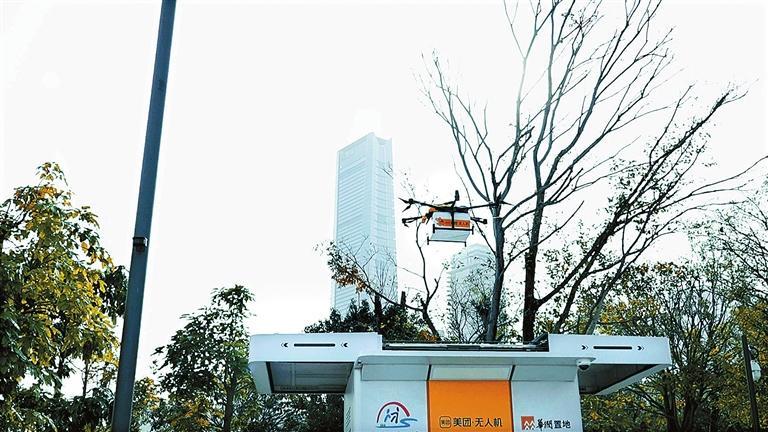
A drone prepares to deliver food into a Meituan pick-up booth in the Shenzhen Talent Park in Nanshan District.

Several food delivery drones prepare for takeoff from the "drone airport" in the Coastal City shopping mall, which is located about one kilometer away from the Shenzhen Talent Park.
Editor's Note:
Since the annual "two sessions" concluded earlier this March, the phrase "new quality productive forces" has emerged as a buzzword and gained widespread attention in the context of China's economic upgrading.
Marked by innovation, new quality productive forces are advanced forms of productivity that represent a departure from traditional economic growth models. These forces align with China's new development philosophy, which prioritizes innovation and sustainability. They encompass high tech, efficiency, and high-quality productivity methods.
On March 14, the city issued an implementation plan for accelerating the development of new quality productive forces to further promote high-quality development of strategic, emerging, and future industries. In the plan, the city adjusted the categories of "20+8" industrial clusters by adding the low-altitude economy and the space and sky industrial cluster to the categories to promote the development of the aerospace industry.
The low-altitude economy is an important force for nurturing and developing new drivers of growth, as well as a typical representative of new quality productive forces.
As a City of Drones, Shenzhen has enhanced its research and development of technology, optimized industrial layout, and improved industrial chains. These improvements will enable the low-altitude economy and the aerospace industry cluster to become a significant engine for future economic growth.
In recent years, Shenzhen's low-altitude economy has vigorously developed through the constant expansion of application scenarios. Data indicate that the 2023 annual output value of Shenzhen's low-altitude economy exceeded 90 billion yuan, a year-on-year increase of 20%.
Shenzhen ranks first in the country in terms of flight scale, according to official figures. Shenzhen launched 126 low-altitude routes and constructed 89 drone takeoff and landing sites in 2023. To date, blood delivery drone routes connect the blood center with 11 hospitals across the city.
Shenzhen Grepow Battery Co., Ltd., a drone battery manufacturer, has pivoted to targeting the niche drone battery market. Lithium-ion batteries have more advantages over other types of batteries in the field of drones due to their small size, light weight, and energy efficiency.
"We have been increasing investment in research and development to drive innovation and technological progress, with a focus on improving battery technology. This technology has tremendous potential and can revolutionize multiple fields. Through technological breakthroughs and innovative allocation of production factors, we have achieved new development," said Li Zengquan, deputy engineer-in-chief of Grepow.
AI+ applications
Artificial intelligence (AI), previously in the software and information service cluster, was changed to an independent category in the new version of the Shenzhen "20+8" industrial clusters, which highlights the importance of AI to the city's industrial development.
On Thursday, Shenzhen Leju Robots Co. Ltd., in partnership with Haier, introduced the world to their household humanoid robot at the Appliance and Electronics World Expo in Shanghai. This is the first humanoid robot designed for household use.
"Artificial intelligence is the core technology of humanoid robots. We cooperate with universities and enterprises engaged in constructing AI data models to develop our products. The city has upgraded AI to an independent industrial cluster, which will be good for matching and integrating resources and introducing talent," said Ke Zhendong, vice president of the Nanshan-based robotics company Leju.
As of 2023, there are 1,920 AI enterprises in Shenzhen with an annual output of 248 billion yuan, a year-on-year increase of 32%. The added value of Shenzhen's digital economy core industry has exceeded 1 trillion yuan.
Since the implementation of Shenzhen's "20+8" industrial cluster initiative in June 2022, the added value of the city's strategic emerging industries has increased by 8.8% to reach 1.45 trillion yuan in 2023.
According to statistics from the Shenzhen Institute of Standards and Technology, the number of newly registered "20+8" enterprises in the city has reached 10,456 in the first two months of the year, accounting for 27.04% of all newly registered enterprises and representing a year-over-year growth rate of 31.69%. Bao'an, Longgang, Nanshan, Futian, and Longhua districts each witnessed the registration of more than 1,000 new enterprises in the "20+8" category.



